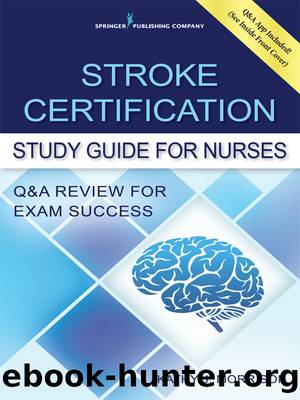Stroke Certification Study Guide for Nurses by Kathy J. Morrison MSN RN CNRN SCRN

Author:Kathy J. Morrison, MSN, RN, CNRN, SCRN
Language: eng
Format: epub
Publisher: Springer Publishing Company, Inc.
Published: 2017-06-09T00:00:00+00:00
In the Stroke Unit
1.On Day 7 postcoiling, your aneurysmal subarachnoid hemorrhage (SAH) patient says she feels good enough to go home and wonders why the doctor said she has to stay another 3 to 4 days. Your answer would be which of the following?
A.Her stroke education has not been completed yet
B.She is at high risk of rebleed
C.She is at high risk of vasospasm
D.Her anticoagulant has not yet reached therapeutic level
2.Your patient with left hemisphere stroke complains of right arm pain and scores it as 3 of 10 on the pain scale. What would your next nursing action be?
A.Educate the patient that pain is a good sign that sensation is intact
B.Notify the provider and anticipate repeat CT scan
C.Document as new pain and include in report to next shift
D.Reposition the patient, ensuring that the affected arm is well supported
3.Your new patient complains of headache and you have an order for acetaminophen PO. You are about to administer a dose when you remember that you were not told whether the patient had a dysphagia screen done in the emergency department (ED). Your next step is to
A.Give the medication anyway because the patient seems alert and able to swallow okay
B.Call the ED and leave a message for the nurse to call you back with the answer
C.Perform the dysphagia screen now
D.Apologize and explain that you will be back in a few minutes after you check the patient’s chart
4.On rounds, Dr. Hamilton, the stroke neurologist, is reviewing Mrs. Smith’s medical record. It is Day 2 for this 72-year-old with a lacunar stroke. What would have made the provider quiz the patient about family history of diabetes?
A.Hgb A1C of 9%
B.Fasting glucose of 122
C.Small vessel disease on CT
D.Remembering another current patient—same last name—with diabetes
5.During rounds, your stroke patient begs Dr. Harms to let him have water, despite the thorough explanation you provided to the patient earlier that he failed the bedside swallow screen and the speech and language pathologist (SLP) will need to do a more thorough evaluation before he can have anything to drink. Dr. Harms states that as this patient can speak clearly and is alert, he must be able to swallow adequately. The provider orders the patient to have liquids as desired. Your best response would be to:
A.Repeat the evidence-based dysphagia screen
B.Accept that the provider is a doctor and in charge, so you get the patient some ice water
C.Ignore the provider’s order, and refuse to give the patient water
D.Page the SLP stat to come and evaluate the patient
6.Postural (orthostatic) hypotension is considered when which of the following conditions is present?
A.A 10-mmHg drop in systolic blood pressure (SBP) after 2 hours of sitting out of bed in a chair
B.A 20-mmHg drop in SBP within 5 minutes of standing after supine rest
C.Hemorrhagic stroke—postural hypotension is not applicable to ischemic stroke
D.A 20-mmHg drop in SBP after initiation of new antihypertensive medication
7.Which of the following is not a recommended treatment for prevention of venous thrombosis?
A.Low–molecular weight heparin
B.Elastic compression stockings, also called thromboembolic disease (TED) stockings
C.Intermittent pneumatic compression (IPC) devices, also called sequential compression devices (SCD)
D.
Download
This site does not store any files on its server. We only index and link to content provided by other sites. Please contact the content providers to delete copyright contents if any and email us, we'll remove relevant links or contents immediately.
1610396766 (N) by Jo Ann Jenkins(1301)
Elizabeth Is Missing by Emma Healey(1234)
McGraw-Hill Nurses Drug Handbook by Patricia Schull(1190)
Economics and Financial Management for Nurses and Nurse Leaders, Third Edition by Susan J. Penner RN MN MPA DrPH CNL(1177)
Cherry Ames Boxed Set, Books 1 - 4 by Helen Wells(1155)
The Language of Kindness by Christie Watson(1120)
NCLEX-RN Prep Plus 2019 by Kaplan Nursing(1103)
Cherry Ames, Student Nurse by Helen Wells(1102)
Spiritual Midwifery by Ina May Gaskin(1082)
Whoever Tells the Best Story Wins: How to Use Your Own Stories to Communicate with Power and Impact by Annette Simmons(1060)
Cherry Ames Boxed Set, Books 5 - 8 by Helen Wells(1055)
Home. by Sarah Graham(1052)
Cracking the Nursing Interview by Jim Keogh(1027)
1476763445 by Liz Fenton(1006)
Dementia by June Andrews(931)
Getting Started with Arduino by Massimo Banzi(925)
Cherry Ames, Army Nurse by Helen Wells(901)
Shadows of the Workhouse: The Drama of Life in Postwar London by Jennifer Worth(892)
Children's Medicines by Edward A. Bell(890)
